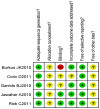The incidence of adjacent segment degeneration after cervical disc arthroplasty (CDA): a meta analysis of randomized controlled trials - PubMed (original) (raw)
Review
The incidence of adjacent segment degeneration after cervical disc arthroplasty (CDA): a meta analysis of randomized controlled trials
Baohui Yang et al. PLoS One. 2012.
Abstract
Background: Cervical disc arthroplasty is being used as an alternative degenerative disc disease treatment with fusion of the cervical spine in order to preserve motion. However, whether replacement arthoplasty in the spine achieves its primary patient centered objective of lowering the frequency of adjacent segment degeneration is not verified yet.
Methodology: We conducted a meta-analysis according to the guidelines of the Cochrane Collaboration using databases including PubMed, Cochrane Central Register of Controlled Trials and Embase. The inclusion criteria were: 1) Randomized, controlled study of degenerative disc disease of the cervical spine involving single segment or double segments using Cervical disc arthroplasty (CDA) with anterior cervical discectomy and fusion (ACDF) as controls; 2) A minimum of two-year follow-up using imaging and clinical analyses; 3) Definite diagnostic evidences for "adjacent segment degeneration" and "adjacent segment disease"; 4) At least a minimum of 30 patients per population. Two authors independently selected trials; assessed methodological quality, extracted data and the results were pooled.
Results: No study has specifically compared the results of adjacent segment degenerative; Two papers describing 140 patients with 162 symptomatic cervical segment disorders and compared the rate of postoperative adjacent segment disease development between CDA and ACDF treatments, three publications describing the rate of adjacent-segment surgery including 1273 patients with symptomatic cervical segments. The result of the meta-analysis indicates that there were fewer the rate of adjacent segment disease and the rate for adjacent-segment surgery comparing CDA with ACDF, but the difference was not statistically significant.
Conclusions: Based on available evidence, it cannot be concluded, that CDA can significantly reduce the postoperative rate of the adjacent segment degenerative and adjacent segment disease. However, due to some limitations, the results of this meta-analysis should be cautiously accepted, and further studies are needed.
Conflict of interest statement
Competing Interests: The authors have declared that no competing interests exist.
Figures
Figure 1. The process of identifying relevant studies is summarized.
Figure 2. Risk of bias summary.
Review authors' judgments about each risk of bias item for each included study. + is “yes”, − is “no”,? is “unclear”.
Figure 3. Forest plot of comparison Adjacent segment disease.
The result indicates that there were fewer Adjacent segment disease comparing CDA to ACDF, but the difference was not statistically significant.
Figure 4. Forest plot of comparison Adjacent segment reoperations.
The result indicates that there were fewer there were fewer Adjacent segment reoperations comparing CDA to ACDF, but the difference was also not statistically significant.
Similar articles
- The change of adjacent segment after cervical disc arthroplasty compared with anterior cervical discectomy and fusion: a meta-analysis of randomized controlled trials.
Dong L, Xu Z, Chen X, Wang D, Li D, Liu T, Hao D. Dong L, et al. Spine J. 2017 Oct;17(10):1549-1558. doi: 10.1016/j.spinee.2017.06.010. Epub 2017 Jun 15. Spine J. 2017. PMID: 28625479 Review. - Adjacent segment degeneration or disease after cervical total disc replacement: a meta-analysis of randomized controlled trials.
Xu S, Liang Y, Zhu Z, Qian Y, Liu H. Xu S, et al. J Orthop Surg Res. 2018 Oct 3;13(1):244. doi: 10.1186/s13018-018-0940-9. J Orthop Surg Res. 2018. PMID: 30285807 Free PMC article. Review.
Cited by
- Long-term functional and radiological outcomes of cervical disc arthroplasty at a tertiary level spine center in India: A retrospective cohort analysis with minimum 2 years of follow-up.
Dave B, Chauhan V, Amin P, Mayi S, Krishnan A, Degulmadi D, Rai RR, Dave M, Bali SK, Charde P, Anil A. Dave B, et al. J Craniovertebr Junction Spine. 2023 Jul-Sep;14(3):268-273. doi: 10.4103/jcvjs.jcvjs_56_23. Epub 2023 Sep 18. J Craniovertebr Junction Spine. 2023. PMID: 37860030 Free PMC article. - Quality assessment of systematic reviews of surgical treatment of cervical spine degenerative diseases: an overview.
Astur N, Martins DE, Kanas M, Mendonça RGM, Creek AT, Lenza M, Wajchenberg M. Astur N, et al. Einstein (Sao Paulo). 2022 Apr 20;20:eAO6567. doi: 10.31744/einstein_journal/2022AO6567. eCollection 2022. Einstein (Sao Paulo). 2022. PMID: 35476082 Free PMC article. - Hybrid implants in anterior cervical decompressive surgery for degenerative disease.
Visocchi M, Marino S, Ducoli G, Barbagallo GMV, Ciappetta P, Signorelli F. Visocchi M, et al. J Craniovertebr Junction Spine. 2021 Jan-Mar;12(1):54-60. doi: 10.4103/jcvjs.JCVJS_184_20. Epub 2021 Mar 4. J Craniovertebr Junction Spine. 2021. PMID: 33850382 Free PMC article. - TCM nonpharmacological interventions for chronic low-back pain: A protocol for systematic review and network meta-analysis.
Yu H, Wang H, Ma T, Huang A, Lu Z, Zhang X. Yu H, et al. Medicine (Baltimore). 2020 Oct 2;99(40):e22547. doi: 10.1097/MD.0000000000022547. Medicine (Baltimore). 2020. PMID: 33019465 Free PMC article.
References
- Bohlman HH, Emery SE, Goodfellow DB, Jones PK. Robinson anterior cervical discectomy and arthrodesis for cervical radiculopathy: Long-term follow-up of one hundred and twenty-two patients. J Bone Joint Surg. 1993;75A:1298–307. - PubMed
- Robinson RA, Smith GW. Anterolateral cervical disc removal and interbody fusion for cervical disc syndrome. Bull Johns Hopkins Hosp. 1995;96:223–224.
- Fuller DA, Kirkpatrick JS, Emery SE, Wilber RG, Davy DT, et al. A kinematic study of the cervical spine before and after segmental arthrodesis. Spine. 1998;23:649–656. - PubMed
- Matsunaga S, Kabayama S, Yamamoto T, Yone K, Sakou T, et al. Strain on intervertebral discs after anterior cervical decompression and fusion. Spine. 1999;24:670–675. - PubMed
- Baba H, Furusawa N, Imura S, Kawahara N, Tsuchiya H, et al. Late radiographic findings after anterior cervical fusion for spondylotic myeloradiculopathy. Spine. 1993;18:2167–2173. - PubMed
Publication types
MeSH terms
LinkOut - more resources
Full Text Sources
Medical



